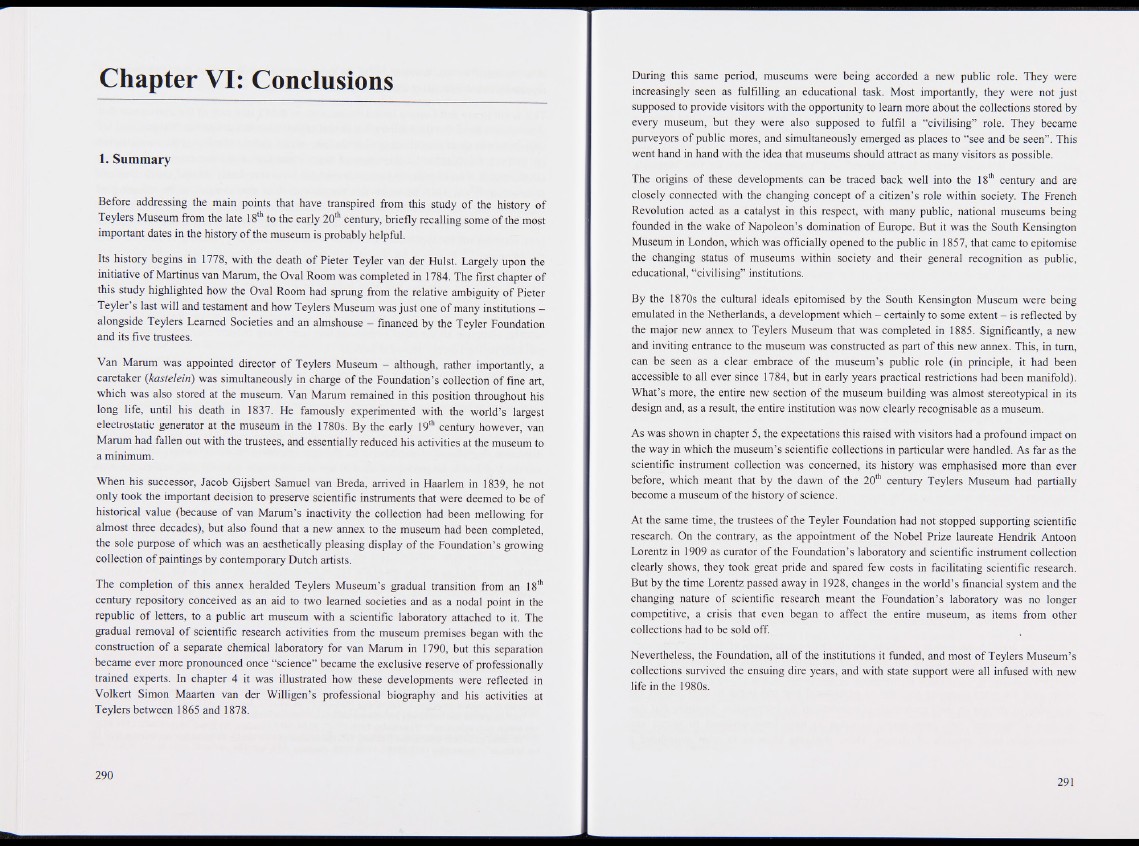
Chapter VI: Conclusions
1. Summary
Before addressing the main points that have transpired from this study of the history of
Teylers Museum from the late 18th to the early 20th century, briefly recalling some of the most
important dates in the history of the museum is probably helpful.
Its history begins in 1778, with the death of Pieter Teyler van der Hulst. Largely upon the
initiative of Martinus van Marum, the Oval Room was completed in 1784. The first chapter of
this study highlighted how the Oval Room had sprung from the relative ambiguity of Pieter
Teyler’s last will and testament and how Teylers Museum was just one of many institutions 1
alongside Teylers Learned Societies and an almshouse — financed by the Teyler Foundation
and its five trustees.
Van Marum was appointed director of Teylers Museum — although, rather importantly, a
caretaker (kastelein) was simultaneously in charge of the Foundation’s collection of fine art,
which was also stored at the museum. Van Marum remained in this position throughout his
long life, until his death in 1837. He famously experimented with the world’s largest
electrostatic generator at the museum in the 1780s. By the early 19th century however, van
Marum had fallen out with the trustees, and essentially reduced his activities at the museum to
a minimum.
When his successor, Jacob Gijsbert Samuel van Breda, arrived in Haarlem in 1839, he not
only took the important decision to preserve scientific instruments that were deemed to be of
historical value (because of van Marum’s inactivity the collection had been mellowing for
almost three decades), but also found that a new annex to the museum had been completed,
the sole purpose of which was an aesthetically pleasing display of the Foundation’s growing
collection of paintings by contemporary Dutch artists.
The completion of this annex heralded Teylers Museum’s gradual transition from an 18th
century repository conceived as an aid to two learned societies and as a nodal point in the
republic of letters, to a public art museum with a scientific laboratory attached to it. The
gradual removal of scientific research activities from the museum premises began with the
construction of a separate chemical laboratory for van Marum in 1790, but this separation
became ever more pronounced once “science” became the exclusive reserve of professionally
trained experts. In chapter 4 it was illustrated how these developments were reflected in
Volkert Simon Maarten van der Willigen’s professional biography and his activities at
Teylers between 1865 and 1878.
During this same period, museums were being accorded a new public role. They were
increasingly seen as fulfilling an educational task. Most importantly, they were not just
supposed to provide visitors with the opportunity to leam more about the collections stored by
every museum, but they were also supposed to fulfil a “civilising” role. They became
purveyors of public mores, and simultaneously emerged as places to “see and be seen”. This
went hand in hand with the idea that museums should attract as many visitors as possible.
The origins of these developments can be traced back well into the 18 century and are
closely connected with the changing concept of a citizen’s role within society. The French
Revolution acted as a catalyst in this respect, with many public, national museums being
founded in the wake of Napoleon’s domination of Europe. But it was the South Kensington
Museum in London, which was officially opened to the public in 1857, that came to epitomise
the changing status of museums within society and their general recognition as public,
educational, “civilising” institutions.
By the 1870s the cultural ideals epitomised by the South Kensington Museum were being
emulated in the Netherlands, a development which - certainly to some extent - is reflected by
the major new annex to Teylers Museum that was completed in 1885. Significantly, a new
and inviting entrance to the museum was constructed as part of this new annex. This, in turn,
can be seen as a clear embrace of the museum’s public role (in principle, it had been
accessible to all ever since 1784, but in early years practical restrictions had been manifold).
What’s more, the entire new section of the museum building was almost stereotypical in its
design and, as a result, the entire institution was now clearly recognisable as a museum.
As was shown in chapter 5, the expectations this raised with visitors had a profound impact on
the way in which the museum’s scientific collections in particular were handled. As far as the
scientific instrument collection was concerned, its history was emphasised more than ever
before, which meant that by the dawn of the 20th century Teylers Museum had partially
become a museum of the history of science.
At the same time, the tmstees of the Teyler Foundation had not stopped supporting scientific
research. On the contrary, as the appointment of the Nobel Prize laureate Hendrik Antoon
Lorentz in 1909 as curator of the Foundation’s laboratory and scientific instrument collection
clearly shows, they took great pride and spared few costs in facilitating scientific research.
But by the time Lorentz passed away in 1928, changes in the world’s financial system and the
changing nature of scientific research meant the Foundation’s laboratory was no longer
competitive, a crisis that even began to affect the entire museum, as items from other
collections had to be sold off.
Nevertheless, the Foundation, all of the institutions it funded, and most of Teylers Museum’s
collections survived the ensuing dire years, and with state support were all infused with new
life in the 1980s.